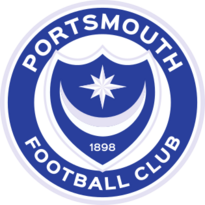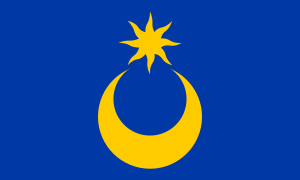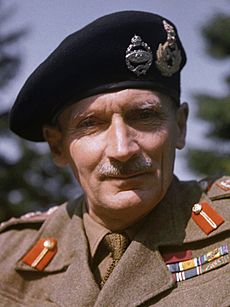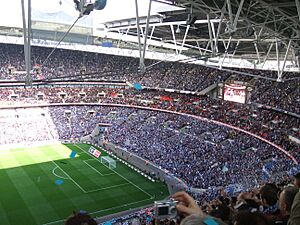Portsmouth F.C. facts for kids
 |
||||
| Full name | Portsmouth Football Club | |||
|---|---|---|---|---|
| Nickname(s) | Pompey | |||
| Founded | 5 April 1898 as "Portsmouth Football and Athletic Company Limited" | |||
| Ground | Fratton Park | |||
| Capacity | 20,899 | |||
| Coordinates | 50°47′47″N 1°3′50″W / 50.79639°N 1.06389°W | |||
| Owner-Chairman | Michael Eisner | |||
| Chief Executive | Andrew Cullen | |||
| Manager | John Mousinho | |||
| League | League One | |||
| 2018–19 | League One, 4th of 24 | |||
|
||||
Portsmouth Football Club, often called Pompey, is a professional football team from Portsmouth, England. They play in the EFL Championship, which is the second-highest league in English football. They earned their spot there by winning the 2023–24 EFL League One title.
The club was started on April 5, 1898. Portsmouth is known for its blue shirts, white shorts, and red socks. They are one of only five English clubs to have won titles in all four professional football leagues. Portsmouth is also the only professional football club in England not located on the mainland, as their home ground, Fratton Park, is on Portsea Island.
Contents
Club History: From Founding to Today
Early Years and Joining the Football League (1898–1920)
Portsmouth F.C. began on April 5, 1898, as "The Portsmouth Football and Athletic Company." The club's home, Fratton Park, was built on farmland and opened in 1899. Frank Brettell became their first manager.
Pompey joined the Southern League First Division in the 1899–1900 season. They quickly found success, finishing second in their first season. They also won the Western Football League Division One championship three times in a row from 1900 to 1903.
After some financial struggles, the club was reorganized in 1912. Football was paused during World War I. When it restarted in 1919–20, Portsmouth won the Southern League championship again. This led to them joining the newly formed Football League Third Division in 1920.
Rising Through the Ranks and FA Cup Glory (1920–1939)
Portsmouth quickly moved up the leagues. They won the Third Division title in 1924 and were promoted to the Second Division. By 1927, they reached the First Division, becoming the first club south of London to do so.
They made it to the FA Cup final twice, in 1929 and 1934, but lost both times. However, in 1939, they finally won the FA Cup, beating Wolverhampton Wanderers 4–1. Because World War II started soon after, the FA Cup competition was stopped. This meant Portsmouth held the trophy for seven years, which is a record!
Post-War Success and Challenges (1946–1979)
After World War II, Portsmouth had their most successful period. They won the English First Division title two years in a row, in 1948–49 and 1949–50. This was a huge achievement for the club.
However, their long stay in the top division ended in 1959 when they were relegated. They faced more relegations in the following years, even dropping to the Fourth Division for the first time in 1978. Despite these challenges, they managed to earn promotions back up in the early 1980s.
Premier League Era and Financial Struggles (2003–2017)
In 2003, Portsmouth won the First Division title and were promoted to the Premier League, the top tier of English football. They stayed there for seven seasons. A major highlight was winning the FA Cup again in 2008, beating Cardiff City 1–0 in the final. This also earned them a spot in the UEFA Cup, their first time playing in a European competition.
After 2010, the club faced serious financial problems, going into administration twice. This led to several relegations. However, in 2013, the club was bought by the Pompey Supporters Trust, which helped them start to recover. They won the EFL League Two title in 2016–17, beginning their climb back up.
Recent Success and Return to the Championship (2017–Present)
In 2017, The Tornante Company, led by Michael Eisner, took over the club. Portsmouth continued to improve, winning the EFL Trophy in 2019.
In the 2023–24 season, Portsmouth had a fantastic year, winning the EFL League One title. This meant they were promoted back to the EFL Championship, ending their 12-year journey outside the top two divisions of English football.
Club Identity and Symbols
Club Badge: Star and Crescent

Portsmouth F.C. got its first club badge in 1913. It was based on the official symbols of the City of Portsmouth: a golden eight-pointed star and a golden crescent moon. These symbols are said to come from King Richard I, who adopted them after capturing Cyprus.
Over the years, the club's badge has changed a few times. For a period between 1980 and 1989, they used a different design featuring a football, an anchor (for the Royal Navy), and a sword (for the British Army). However, the club eventually returned to variations of the traditional star and crescent.
In 2018, new badge designs were introduced for shirts and merchandise, still featuring the star and crescent, but with updated shapes.
Home Colours: Blue, White, and Red
Portsmouth's first home kit in 1899 was salmon pink shirts with maroon details, white shorts, and black socks. This earned them the nickname 'The Shrimps'.
In 1912, they switched to azure blue shirts, white shorts, and black socks. The blue became royal blue in 1933. After World War II, in 1947, the black socks were changed to red. This blue, white, and red combination has been their main home kit ever since.
The Red Socks Story
Before 1947, Portsmouth mostly wore black socks. Field Marshal Sir Bernard 'Monty' Montgomery, a famous British Army leader, was an honorary President of Portsmouth F.C. He suggested adding red socks to the kit. Red is the traditional colour of the British Army and the Remembrance poppy. The red socks were introduced as a way to remember soldiers lost in wartime. This also made the team's colours match the Union Flag (the UK flag), and they were kept for good luck because the club became very successful around that time.
Away Colours
Portsmouth's away kits have most often been white shirts with royal or navy blue shorts, and either blue or white socks.
Kit Manufacturers and Sponsors
Portsmouth has had various kit manufacturers and sponsors over the years. Currently, Nike makes their kits, and the University of Portsmouth is their main shirt sponsor.
The "Pompey" Nickname
The nickname "Pompey" has been linked to Portsmouth Football Club and the city for a long time. No one knows the exact origin, but there are many ideas about where it came from. It's a local nickname used by both the city and the Royal Navy base there.
Fratton Park: The Home Ground
Portsmouth plays its home games at Fratton Park, located in the Milton area of Portsmouth. The club has played here since it was founded. The stadium was designed by Alfred Bone and first opened on August 15, 1899.
The first match at Fratton Park was a friendly against Southampton on September 6, 1899, which Portsmouth won 2–0. Over the years, the stadium has been expanded and updated. The record attendance at Fratton Park was 51,385 supporters on February 26, 1949, for an FA Cup match against Derby County.
Training Ground
Portsmouth F.C. has used its training ground in the Hilsea area of Portsea Island since 2014. The club bought the facilities in 2021 and has refurbished them for the team's use.
Rivalries and Supporters
South Coast Derby
Portsmouth's biggest rivals are Southampton, located about 20 miles away. This rivalry is known as the South Coast Derby. Because the teams are often in different leagues, these matches don't happen very often, which makes them even more intense when they do.
As of June 2024, Portsmouth has won 21 of the 71 matches against Southampton, while Southampton has won 35, and 15 have been draws. The most recent game was in September 2019 in the EFL Cup, where Southampton won 4–0. The last league game between them was a 2–2 draw in April 2012. With Southampton being relegated from the Premier League in the 2024-25 season, the two clubs will play each other in the 2025-26 EFL Championship season.
Portsmouth fans often call Southampton fans "Scummers," and Southampton fans call Portsmouth fans "Skate." These nicknames have historical roots.
Other Rivalries
Another rivalry is with Plymouth Argyle, sometimes called the "Dockyard Derby" or "Battle of the Ports." In recent years, a minor rivalry has also grown with Sunderland due to several important matches between them.
'The Pompey Chimes'
"The Pompey Chimes" is a very old and famous chant sung by Portsmouth supporters. It started with supporters of the Royal Artillery (Portsmouth) Football Club in the 1890s. They would sing along with the chimes of the nearby Portsmouth Town Hall clock, which marked the end of matches.
The original words were: Play up Pompey,
Just one more goal!
Make tracks! What ho!
Hallo! Hallo!!
When Portsmouth F.C. was founded, many of these fans switched their support and brought the chant and the "Pompey" nickname with them to Fratton Park. Today, the chant is sung faster and usually goes:
Play up Pompey,
Pompey play up!
Play up Pompey,
Pompey play up!
Fans often sing it to encourage the team, especially before set-piece kicks like free kicks or corners.
Club Records
- Highest Home Attendance: 51,385 vs. Derby County in 1949 (FA Cup).
- Highest Neutral Venue Attendance: 99,370 vs. Wolverhampton Wanderers in the 1939 FA Cup final at Wembley Stadium.
- Current Wembley Stadium Attendance Record (football): 89,874 in the 2008 FA Cup final.
- Biggest Win: 9–1 vs. Notts County in 1927.
- Biggest Defeat: 10–0 vs. Leicester City in 1928.
- Highest Scoring Game: 7–4 (11 goals total) vs. Reading in 2007.
- Most Consecutive Wins: 9 (from January 4 to February 8, 2020).
- Most Appearances: 845 by Jimmy Dickinson (1946–1965).
- Most League Goals: 194 by Peter Harris (1946–1960).
- Most Goals in a Season: 42 by Guy Whittingham (1992–93).
- Most Goals for Club: 208 by Peter Harris (1946–1960).
- Most International Caps while at Club: 48 by Jimmy Dickinson (for England).
- Record Transfer Received: £20 million from Real Madrid for Lassana Diarra in December 2008.
- Record Transfer Paid: £11 million to Liverpool for Peter Crouch in July 2008.
Portsmouth in Europe
Portsmouth has played in European competitions once, in the 2008–09 UEFA Cup. They beat Vitória de Guimarães to reach the group stage. There, they won one game and drew with AC Milan, but were knocked out after losing to VfL Wolfsburg.
| Season | Competition | Round | Opponents | Home | Away | Aggregate |
|---|---|---|---|---|---|---|
| 2008–09 | UEFA Cup | R1 | 2–0 | 2–2 | 4–2 | |
| Group | – | 3–0 | – | |||
| 2–2 | – | – | ||||
| – | 3–2 | – | ||||
| 3–0 | – | – |
Players
Current Squad
|
|
Players on Loan
|
|
Special Shirt Numbers
- Number 1 was temporarily retired in 2001–02 to honor goalkeeper Aaron Flahavan, who passed away.
- Number 12 is reserved for the Portsmouth fans, showing they are the "twelfth player" on the team.
- Number 58 belongs to "Nelson," the club's mascot.
Portsmouth Player of the Season
This award is given to the best player each season. Here are some of the winners:
- 1968 –
 Ray Pointer
Ray Pointer - 1969 –
 John Milkins
John Milkins - 1970 –
 Nicky Jennings
Nicky Jennings - 1971 –
 David Munks
David Munks - 1972 –
 Richie Reynolds
Richie Reynolds - 1974 –
 Paul Went
Paul Went - 1975 –
 Mick Mellows
Mick Mellows - 1976 –
 Paul Cahill
Paul Cahill - 1979 –
 Peter Mellor
Peter Mellor - 1980 –
 Joe Laidlaw
Joe Laidlaw - 1982 –
 Alan Knight
Alan Knight - 1983 –
 Alan Biley
Alan Biley - 1984 –
 Mark Hateley
Mark Hateley - 1985 –
 Neil Webb
Neil Webb - 1986 –
 Noel Blake
Noel Blake - 1987 –
 Noel Blake
Noel Blake - 1988 –
 Barry Horne
Barry Horne - 1989 –
 Micky Quinn
Micky Quinn - 1990 –
 Guy Whittingham
Guy Whittingham - 1991 –
 Martin Kuhl
Martin Kuhl - 1992 –
 Darren Anderton
Darren Anderton - 1993 –
 Paul Walsh
Paul Walsh - 1994 –
 Kit Symons
Kit Symons - 1995 –
 Alan Knight
Alan Knight - 1996 –
 Alan Knight
Alan Knight - 1997 –
 Lee Bradbury
Lee Bradbury - 1998 –
 Andy Awford
Andy Awford - 1999 –
 Steve Claridge
Steve Claridge - 2000 –
 Steve Claridge
Steve Claridge - 2001 –
 Scott Hiley
Scott Hiley - 2002 –
 Peter Crouch
Peter Crouch - 2003 –
 Linvoy Primus
Linvoy Primus - 2004 –
 Arjan de Zeeuw
Arjan de Zeeuw - 2005 –
 Dejan Stefanović
Dejan Stefanović - 2006 –
 Gary O'Neil
Gary O'Neil - 2007 –
 David James
David James - 2008 –
 David James
David James - 2009 –
 Glen Johnson
Glen Johnson - 2010 –
 Jamie O'Hara
Jamie O'Hara - 2011 –
 Hayden Mullins
Hayden Mullins - 2012 –
 Ricardo Rocha
Ricardo Rocha - 2013 –
 Johannes Ertl
Johannes Ertl - 2014 –
 Ricky Holmes
Ricky Holmes - 2015 –
 Jed Wallace
Jed Wallace - 2016 –
 Michael Doyle
Michael Doyle - 2017 –
 Enda Stevens
Enda Stevens - 2018 –
 Matt Clarke
Matt Clarke - 2019 –
 Matt Clarke
Matt Clarke - 2020 –
 Christian Burgess
Christian Burgess
Portsmouth Hall of Fame
Since 2009, Portsmouth has honored former players and staff by inducting them into a Hall of Fame. Some famous names include Jimmy Dickinson, Peter Harris, and Alan Knight.
Women's Team
Portsmouth also has a women's team, Portsmouth Women, founded in 1987. They play in the FA Women's National League South. In 2023, the women's team became semi-professional, meaning players are paid for their football.
Club Management
Coaching and Staff Positions
| Position | Staff |
|---|---|
| Chairman | Michael Eisner |
| CEO | Andrew Cullen |
| Manager | |
| Assistant manager | |
| Goalkeeping coach | |
| Mascots | Nelson & Pompey Sailor |
Club Ownership
Portsmouth Football Club has had several different owners throughout its history. Since April 2013, the club has been owned by "Portsmouth Community Football Club Limited." The current owner, The Tornante Company, bought the club from the Portsmouth Supporters Trust in August 2017.
Affiliated Clubs
Portsmouth has close ties with other local football clubs. They often play friendly matches with Havant & Waterlooville. They also have a relationship with Gosport Borough, playing friendlies and loaning players to them.
Honours and Trophies
Portsmouth is one of only five English football clubs to have won titles in all four professional leagues.
League Titles
- First Division (Tier 1):
- Champions: 1948–49, 1949–50
- Second Division / First Division (Tier 2):
- Champions: 2002–03
- Third Division South / Third Division / League One (Tier 3):
- Champions: 1923–24, 1961–62, 1982–83, 2023–24
- Fourth Division / League Two (Tier 4):
- Champions: 2016–17
- Southern League First Division:
- Champions: 1901–02, 1919–20
- Western League First Division:
- Champions: 1900–01, 1901–02, 1902–03
Cup Wins
- FA Cup:
- Winners: 1938–39, 2007–08
- FA Charity Shield / Community Shield:
- Winners: 1949 (shared)
- EFL Trophy:
- Winners: 2018–19
- Hampshire Senior Cup:
- Winners: 1902–03, 1912–13, 1951–52, 1986–87
See also
 In Spanish: Portsmouth Football Club para niños
In Spanish: Portsmouth Football Club para niños




